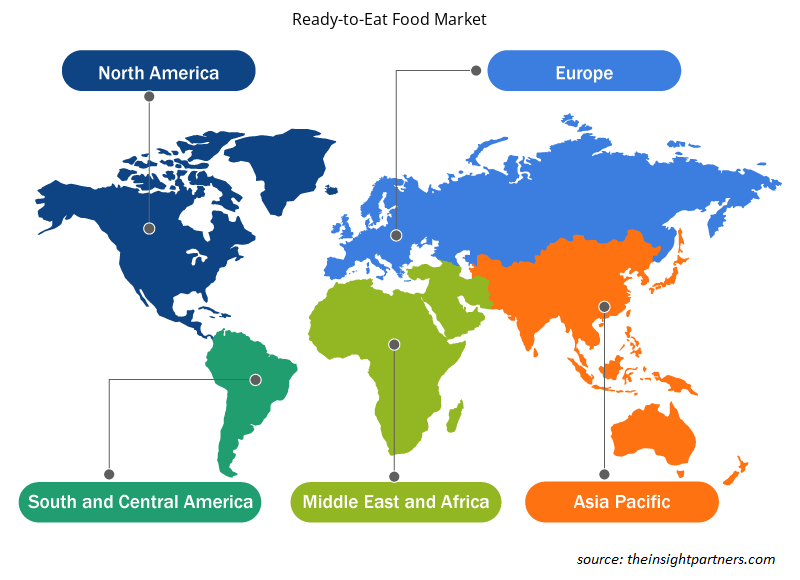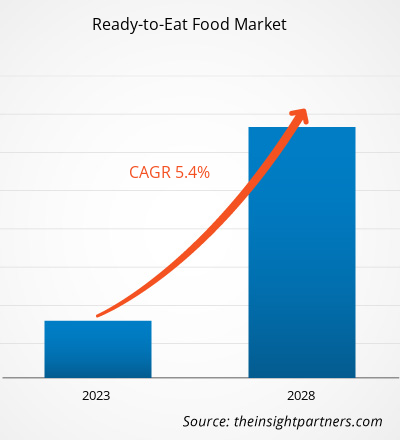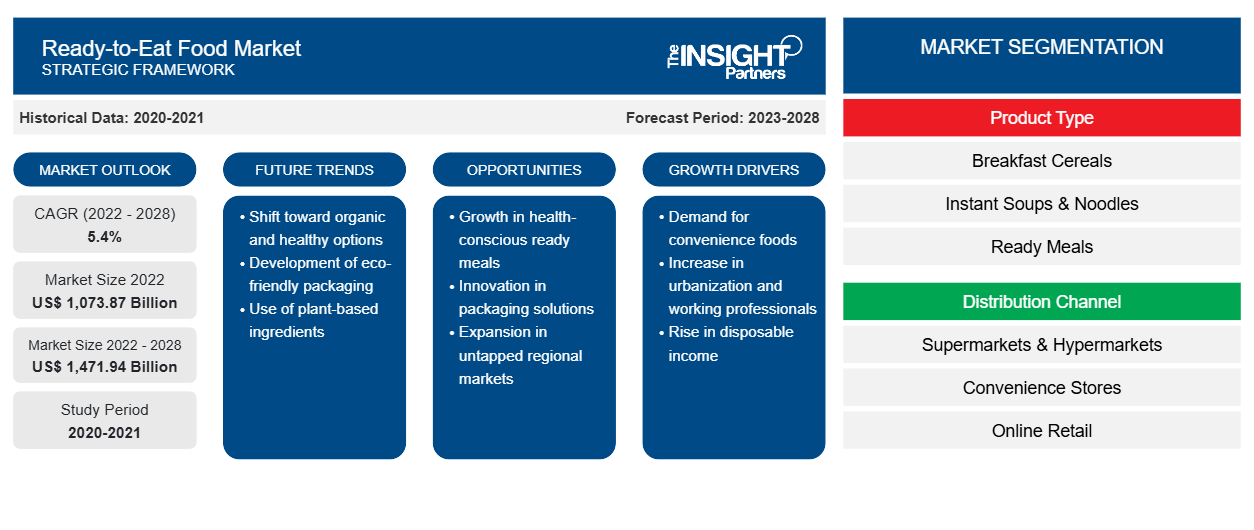[Rapport de recherche] Le marché des aliments prêts à consommer devrait atteindre 1 471,94 milliards de dollars américains d'ici 2028, contre 1 073,87 milliards de dollars américains en 2022. Il devrait croître à un TCAC de 5,4 % de 2022 à 2028.CAGR of 5.4% from 2022 to 2028.
Les aliments prêts à consommer sont constitués de divers aliments transformés et emballés qui peuvent être consommés sans autre préparation. Les ingrédients sont lavés, cuits, transformés et emballés dans des contenants pour une consommation directe. Parmi les types courants d'aliments prêts à consommer, on trouve les soupes instantanées, les produits de boulangerie, les desserts et les plats préparés. Ces produits sont enrichis de divers extraits, acides, arômes, édulcorants , antioxydants et conservateurs. Ils offrent une immense commodité au consommateur tout en contribuant à réduire le temps de préparation des repas et en offrant une durée de conservation plus longue des produits, une rentabilité et une détérioration minimale.
En 2020, l’Asie-Pacifique détenait la plus grande part du marché des aliments prêts à consommer , tandis que d’autres régions en développement, comme le Moyen-Orient et l’Afrique, devraient connaître une croissance significative au cours de la période de prévision. Les principaux acteurs opérant sur le marché des aliments prêts à consommer étendent leurs activités dans toute l’Asie-Pacifique en raison de l’augmentation de la population active et du mode de vie frénétique des habitants des pays en développement. Les particuliers choisissent de plus en plus de consommer des aliments sur le pouce ou à l’extérieur de la maison.
De plus, de nombreuses études ont démontré que les sociétés transnationales du secteur agroalimentaire ont façonné les systèmes alimentaires et la consommation générale d’une manière qui modifie la disponibilité, l’attrait, le prix et, en fin de compte, la consommation des aliments transformés. La croissance du marché des aliments prêts à consommer a été particulièrement observée dans les pays à revenu intermédiaire.TFBCs) have shaped food systems and general consumption in ways, which change the availability, desirability, price, and ultimately consumption of processed foods. The growth of ready-to-eat food market has been prominently observed in middle-income countries.
Personnalisez ce rapport en fonction de vos besoins
Vous bénéficierez d'une personnalisation gratuite de n'importe quel rapport, y compris de certaines parties de ce rapport, d'une analyse au niveau des pays, d'un pack de données Excel, ainsi que de superbes offres et réductions pour les start-ups et les universités.
-
Obtenez les principales tendances clés du marché de ce rapport.Cet échantillon GRATUIT comprendra une analyse de données, allant des tendances du marché aux estimations et prévisions.
Impact de la pandémie de COVID-19 sur le marché des aliments prêts à consommer
La pandémie de COVID-19 a posé des défis sans précédent à de nombreux secteurs au début de l'année 2020. Les confinements, les restrictions aux frontières, les interdictions de voyager, l'arrêt de la fabrication et d'autres mesures de sécurité mises en place par les gouvernements conformément aux directives de l'OMS et des ministères nationaux de la santé ont entravé les opérations de fabrication. D'autre part, l'épidémie de COVID-19 a eu un impact positif sur le marché des aliments prêts à consommer, car les consommateurs et les détaillants ont accumulé des stocks de produits alimentaires prêts à consommer avec des étagères plus longues. De plus, les consommateurs à la recherche de produits alimentaires et de boissons emballés plus sains pour renforcer leur immunité ont été alarmés par l'impact de la COVID-19. Ensuite, les fabricants de produits RTE se sont concentrés sur des produits sains et nutritifs enrichis en protéines et autres valeurs nutritionnelles, ce qui a stimulé la demande de produits alimentaires prêts à consommer pendant la pandémie.Lockdowns, border restrictions, travel bans, manufacturing discontinuation, and other safety measures rolled out by governments as per the guidelines of the WHO, and national health ministries hampered the manufacturing operations. On the other hand, the COVID-19 outbreak positively impacted the ready-to-eat food market as consumers and retailers were stockpiling convenience food products with longer shelves. Also, consumers looking for healthier packaged food and beverage products to boost immunity were alarmed by the COVID-19 impact. Then, manufacturers of RTE products focused on healthy and nutritious products with enrichment of proteins and other nutritional values, which stimulated the demand for ready-to-eat food products during the pandemic.
Perspectives du marché
La forte préférence pour les aliments de commodité chez les Millennials stimule la croissance du marchéMillennials Drives Market Growth
La consommation de produits alimentaires prêts à consommer de haute qualité est en hausse, ce qui constitue actuellement l'une des plus grandes tendances de l'industrie alimentaire. Les aliments prêts à consommer, tels que les produits RTE, permettent aux consommateurs d'économiser du temps et des efforts liés à la préparation et à la cuisson des repas, à la consommation et aux activités post-repas. Les sources de développement de ce segment alimentaire sont, selon certaines sources, les nombreux changements sociaux, notamment le nombre croissant de ménages plus petits et l'augmentation de la population des milléniaux à travers le monde. En raison des horaires de travail chargés des milléniaux, ils préfèrent être efficaces avec leur temps plutôt que de le gaspiller sur des tâches fastidieuses. Ils sont plus susceptibles de dépenser leur argent pour des produits pratiques. Ainsi, ils préfèrent de plus en plus les produits RTE, tels que les produits de boulangerie, les snacks et les produits laitiers, ce qui stimule encore davantage le marché des aliments prêts à consommer.millennials, they prefer to be efficient with their time rather than wasting it on tedious tasks. They are more likely to spend their money on convenience. Thus, they increasingly prefer RTE products, such as baked products, snacks, and dairy products, further driving the ready-to-eat food market.
Informations sur les types de produits
Français En fonction du type de produit, le marché des aliments prêts à consommer est segmenté en céréales pour petit-déjeuner, soupes et nouilles instantanées, plats préparés, collations, produits de boulangerie et confiseries, et autres. L'autre segment des aliments prêts à consommer devrait enregistrer la plus grande part au cours de la période de prévision. Les autres types comprennent les produits laitiers, les desserts, les tartinades, les sauces et les trempettes. Les produits laitiers RTE comprennent la crème glacée, le yaourt, le lait aromatisé conditionné et le fromage. Les consommateurs soucieux de leur santé consomment principalement des produits laitiers, car les produits laitiers ordinaires améliorent la santé des os et des intestins et réduisent les risques de maladies cardiovasculaires (MCV) et de diabète de type 2. La popularité des sauces et trempettes transformées et conditionnées a augmenté à mesure que les gens abandonnaient leurs modes de vie traditionnels et adoptaient un mode de vie moderne, alimentant la croissance du marché des aliments prêts à consommer.CVDs) and type 2 diabetes. The popularity of processed and packaged sauces and dips grew as people switched from traditional ways of living and adopted a modern lifestyle, fueling the growth of ready-to-eat food market.
Aperçu régional du marché des aliments prêts à consommer
Les tendances et facteurs régionaux influençant le marché des aliments prêts à consommer tout au long de la période de prévision ont été expliqués en détail par les analystes d'Insight Partners. Cette section traite également des segments et de la géographie du marché des aliments prêts à consommer en Amérique du Nord, en Europe, en Asie-Pacifique, au Moyen-Orient et en Afrique, ainsi qu'en Amérique du Sud et en Amérique centrale.

- Obtenez les données régionales spécifiques au marché des aliments prêts à consommer
Portée du rapport sur le marché des aliments prêts à consommer
| Attribut de rapport | Détails |
|---|---|
| Taille du marché en 2022 | 1 073,87 milliards de dollars américains |
| Taille du marché d'ici 2028 | 1 471,94 milliards de dollars américains |
| Taux de croissance annuel composé mondial (2022-2028) | 5,4% |
| Données historiques | 2020-2021 |
| Période de prévision | 2023-2028 |
| Segments couverts |
Par type de produit
|
| Régions et pays couverts |
Amérique du Nord
|
| Leaders du marché et profils d'entreprises clés |
|
Densité des acteurs du marché des aliments prêts à consommer : comprendre son impact sur la dynamique commerciale
Le marché des aliments prêts à consommer connaît une croissance rapide, stimulé par la demande croissante des utilisateurs finaux en raison de facteurs tels que l'évolution des préférences des consommateurs, les avancées technologiques et une plus grande sensibilisation aux avantages du produit. À mesure que la demande augmente, les entreprises élargissent leurs offres, innovent pour répondre aux besoins des consommateurs et capitalisent sur les tendances émergentes, ce qui alimente davantage la croissance du marché.
La densité des acteurs du marché fait référence à la répartition des entreprises ou des sociétés opérant sur un marché ou un secteur particulier. Elle indique le nombre de concurrents (acteurs du marché) présents sur un marché donné par rapport à sa taille ou à sa valeur marchande totale.
Les principales entreprises opérant sur le marché des aliments prêts à consommer sont :
- Nestlé SA
- Conagra Brands Inc.
- La société Kraft Heinz
- Général Mills Inc.
- COMPAGNIE DE SOUPES CAMPBELL
Avis de non-responsabilité : les sociétés répertoriées ci-dessus ne sont pas classées dans un ordre particulier.

- Obtenez un aperçu des principaux acteurs du marché des aliments prêts à consommer
Informations sur les canaux de distribution
En fonction du canal de distribution, le marché des aliments prêts à consommer a été segmenté en supermarchés et hypermarchés, magasins de proximité, vente au détail en ligne et autres. Le segment de la vente au détail en ligne devrait enregistrer le TCAC le plus élevé sur le marché des aliments prêts à consommer au cours de la période de prévision. La vente au détail en ligne offre une expérience d'achat pratique aux utilisateurs, suivie d'une livraison simplifiée des produits. Les magasins de vente au détail en ligne proposent une large gamme de produits à des prix très réduits ; les consommateurs peuvent également acheter facilement les produits souhaités à distance.
Les principaux acteurs du marché des aliments prêts à consommer sont Nestlé SA ; Conagra Brands Inc. ; The Kraft Heinz Company ; General Mills Inc. ; CAMPBELL SOUP COMPANY ; MTR Foods Pvt Ltd. ; Hormel Foods Corporation ; Tyson Foods, Inc. ; JBS SA ; et The Kellogg Company. Ces acteurs se consacrent au développement de produits présentant des risques sanitaires réduits pour répondre aux nouvelles tendances de consommation et respecter les cadres réglementaires. Ils participent à des fusions et acquisitions, à des expansions d'entreprises et à des partenariats pour accroître leur part de marché.
Rapports en vedette
- Tendances industrielles progressistes sur le marché des aliments prêts à consommer pour aider les acteurs à développer des stratégies efficaces à long terme
- Stratégies de croissance des entreprises adoptées pour assurer la croissance sur les marchés développés et en développement
- Analyse quantitative du marché des aliments prêts à consommer de 2019 à 2028
- Estimation de la demande mondiale en aliments prêts à consommer
- Analyse des cinq forces de Porter pour illustrer l'efficacité des acheteurs et des fournisseurs opérant dans l'industrie
- Développements récents pour comprendre le scénario concurrentiel du marché
- Tendances et perspectives du marché et facteurs régissant la croissance du marché des aliments prêts à consommer
- Aide à la prise de décision en mettant en évidence les stratégies de marché qui sous-tendent l'intérêt commercial, conduisant à la croissance du marché
- Taille du marché des aliments prêts à consommer à différents points névralgiques
- Aperçu détaillé et segmentation du marché et de la dynamique de l'industrie des produits RTE
- Ampleur de la croissance dans diverses régions présentant des opportunités de croissance prometteuses
- Analyse historique (2 ans), année de base, prévision (7 ans) avec TCAC
- Analyse PEST et SWOT
- Taille du marché Valeur / Volume - Mondial, Régional, Pays
- Industrie et paysage concurrentiel
- Ensemble de données Excel
Rapports récents
Rapports connexes
Témoignages
Raison d'acheter
- Prise de décision éclairée
- Compréhension de la dynamique du marché
- Analyse concurrentielle
- Connaissances clients
- Prévisions de marché
- Atténuation des risques
- Planification stratégique
- Justification des investissements
- Identification des marchés émergents
- Amélioration des stratégies marketing
- Amélioration de l'efficacité opérationnelle
- Alignement sur les tendances réglementaires





















 Obtenez un échantillon gratuit pour - Marché de produits alimentaires prêts à manger
Obtenez un échantillon gratuit pour - Marché de produits alimentaires prêts à manger